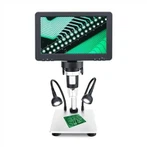Principle of anemometer and problems when using it
The basic principle of an anemometer is to place a thin metal wire in the fluid and pass current to heat the wire so that its temperature is higher than the temperature of the fluid, so the metal wire anemometer is called "." When the fluid flows through the metal wire in the vertical direction, it will take away part of the heat from the metal wire, causing the temperature of the metal wire to drop. According to the theory of forced convection heat exchange, the relationship between the lost heat Q and the velocity v of the fluid can be derived. A standard probe consists of two brackets stretching a short, thin metal wire, as shown in Figure 2.1. Metal wire is usually made of metals with high melting points and good ductility such as platinum, rhodium, and tungsten. Commonly used wires have a diameter of 5μm and a length of 2mm; the smallest probe has a diameter of only 1μm and a length of 0.2mm.
According to different uses, the probe is also made into double wire, triple wire, oblique wire, V shape, X shape, etc. In order to increase the strength, a metal film is sometimes used instead of a metal wire. A thin metal film is usually sprayed on a thermally insulating substrate, which is called a hot film probe. The probe must be calibrated before use. Static calibration is carried out in a special standard wind tunnel, and the relationship between flow velocity and output voltage is measured and drawn into a standard curve; dynamic calibration is carried out in a known pulsating flow field, or by adding a heating circuit to the anemometer. Use the last pulsating electrical signal to verify the frequency response of the anemometer. If the frequency response is not good, you can use the corresponding compensation circuit to improve it.
The flow velocity measurement range of 0 to 100m/s can be divided into three sections: low speed: 0 to 5m/s; medium speed: 5 to 40m/s; high speed: 40 to 100m/s. The thermal probe of the anemometer is used for measurements from 0 to 5m/s; the wheel probe of the anemometer is ideal for measuring flow rates from 5 to 40m/s; and the pitot tube is used to obtain the best results in the high-speed range. . An additional criterion for the correct selection of the flow velocity probe of an anemometer is the temperature. Usually the operating temperature of the thermal sensor of an anemometer is about +-70C. The wheel probe of the special anemometer can reach 350C. Pitot tube is used above +350C.






